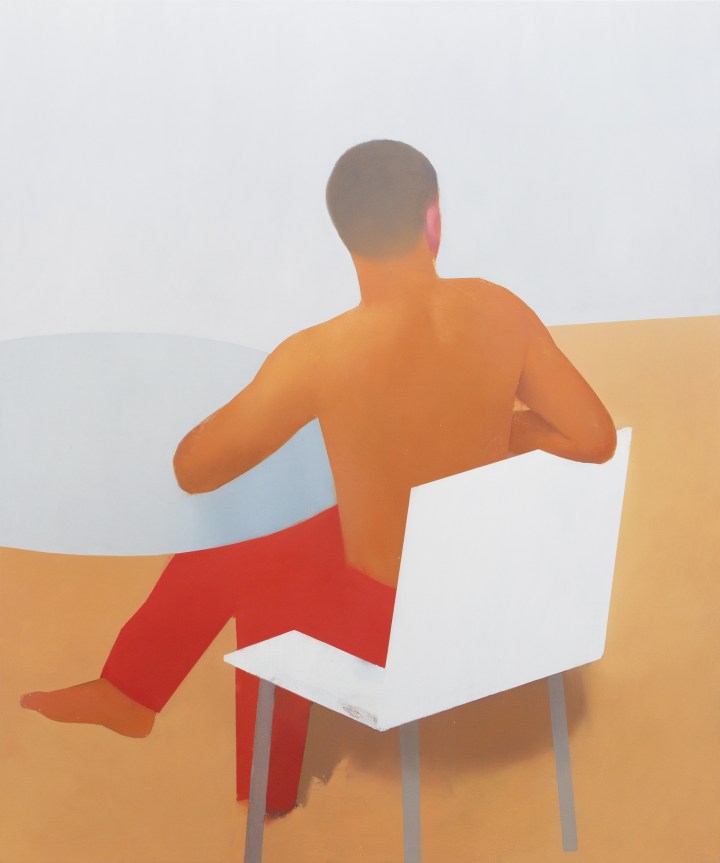Manuel Stehli
Artwork’s Title: Untitled
Materials Used: Oil on canvas
Studio Based: Berlin, Germany

Can you tell us about the process of making your work?
It’s probably more chaotic than one might expect looking at my paintings. I usually start with a rather vague idea that serves as a basis, but mostly gets lost or transmuted later in the process. This idea can either be focused on content matter (such as a specific gesture, posture or a certain kind of interaction between people) or on more abstract aspects (such as the way objects are spread across the canvas or a certain set of colours). I have been collecting countless images of postures, gestures and situations that I source my paintings from. These images are mostly photographic, sometimes computer-generated and barely ever of any personal relation to me. Lately I have been particularly interested in stock imagery, with its strange mix of randomness and functionality, the way it forces a universal readability upon people and things. In the painting process I use fragments of these images, reassembling and alienating them in a way that may defy the readability of the source material. There is a lot of shifting, rejecting and readjusting going on in the painting process – to an extent that often makes me lose control over the painting and lose track of my ideas. That is where the process usually becomes interesting. Gradually, and often accidentally, a sense of delicacy and personality or integrity may emerge and contrast with the interchangeability of the fragments. It is a certain kind of limbo or tension between those poles I look for as a result.
How would you define your work in a few words (ideally in 3 words)?
Still, plain, ambiguous.
Would you use another three different words to describe the ‘Untitled’ painting?
Not quite so still maybe.
How did you come up with this painting idea? Is there any story behind this painting?
This painting was originally intended to show three figures, but somewhere in the process the third figure disappeared. My starting point was a photograph showing a group of men at a festival or a demonstration, waiting for a barrier to be opened. What interested me about this motif was the particular body language of the men, conveying a sense of power and insecurity at the same time. As a reaction to the slightly degrading and discomforting situation of having to wait, the men seemed to have taken on more cliché masculine postures and moved closer together. The latter undoubtedly lends the group a more threatening appearance, but also makes the individuals look somewhat clumsy and childlike.
While the finished painting barely has anything to do with the source photograph it still revolves around those observations. It’s about the notion of waiting, or having to wait, and thus both feeling entitled to and being at the mercy of something. And then there’s the relation of masculinity and intimacy. These things have been on my mind for a while now and come together in this painting.
What colour is used the most in this painting?
Titanium white.
What would be the best way to exhibit your work?
I wouldn’t say there is a best way. But the paintings need enough space around them, ideally on white walls.
Can you mention any artists you, lately or generally, take inspiration from?
Piero Della Francesca, Henry Taylor, Marlene Dumas, David Hockney, Arthur Jafa, Helen Levitt, Archaic Greek Kouroi, Marianne Wex, Pier Paolo Pasolini and others
Has self-isolation because of Convid-19 affected your creative activities or behaviour so far? If so, in which ways?
All the confusion and worries aside, the situation has led to a more focused way of working. There is simply less distraction and less pressure due to cancelled or postponed deadlines. The latter is a problem for obvious reasons, but it also means more freedom to experiment at the risk of failure.
What about the place where you work? What’s your studio space look like?
I moved into a new studio at the beginning of the year and am very happy about it. It’s a bright, more spacious room in the same old industrial building where I had been working before. The additional space allows me to work on, or just look at, several large canvases at a time which is a big advantage over my previous studio. Last but not least it had a spare corner for a daybed.
What does your mum think about your art?
She seems to like it.
Which exhibition did you visit last?
A group show with Christa Joo Hyun D‘Angelo, Bianca Kennedy and my friend Zohar Fraiman at Russi Klenner, Berlin – last Saturday.
Which are your plans for the near future?
A solo show at the Czech Centre in Berlin, opening in mid-June. Also, to visit family and friends in Switzerland and the Czech Republic as soon as it’s possible.
*Manuel Stehli was born in 1988 in Zurich, lives and works between Berlin and Zurich. He studied under Annette Schröter at the HGB Leipzig and at the Camberwell Collage of Arts in London under Daniel Sturgis. In 2017, the artist was awarded the Windsor & Newton Residency at Künstlerhaus Bethanien in Berlin.
Additional Paintings



© All images are courtesy of the artist
